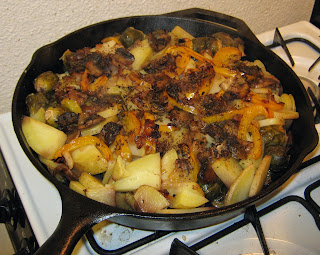- 1 large shallot finely chopped
- ¼ large onion finely chopped
- 4 large mushrooms ¼" slices
- ¾ yellow bell pepper thinly sliced spears
- ½ stick butter
- 0.625 lb top sirloin steak
- 2 pinches coarse sea salt
- 3 large dashes of dried basil
- 5 large yukon gold potatoes ⅛" slices
- 1 lb brussel sprouts whole
- 12 fl oz heartland stickleback red wine
Saute onion & shallot in ¼ stick butter for a few minutes then add mushrooms, sweet pepper and the rest of the butter.
In another large cast iron pan for which you have a lid thoroughly brown the steak and surround with potatoes and brussel sprouts.
Once onions, shallots, mushrooms and peppers are beginning to brown cover the top of the potatoes and brussel sprouts with them.
Sprinkle course sea salt and basil then pour the wine over the top. Place in oven at 400° for 75 minutes.
Serves 4 generously.
